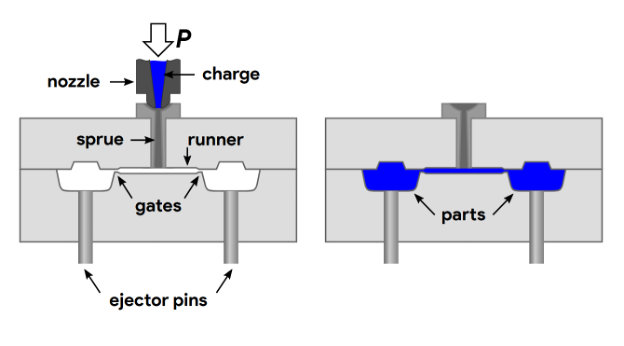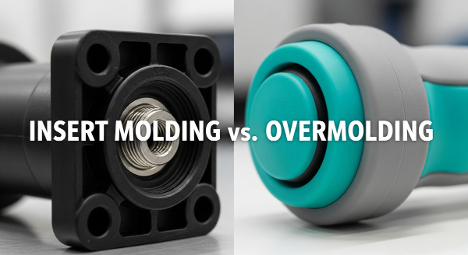ABS( Acrylonitrile Butadiene Styrene) injection molding stands at the forefront of modern manufacturing, offering a versatile and cost-effective solution for producing a wide range of plastic components. This article delves into the intricacies of ABS injection molding, exploring its definition, applications, and the reasons used ABS in injection molding.
Definition
ABS is a thermoplastic polymer known for its durability, impact resistance, and heat resistance. The ABS injection molding process involves melting the ABS resin pellets and injecting the molten material into a mold to create desired shape upon cooling and solidification. The acronym ABS reflects its three main components: Acryloitrile, Butadience, and Stryene.
What Are the Application of ABS Injection Molding?
ABS injection molding is utilized across various industries due to the material’s versatile properties. The applications of ABS injection molding are diverse, ranging from consumer goods to industrial components. Here are some common applications:
1. Automotive Parts
ABS is widely used in the automotive industry for manufacturing various components, including interior and exterior trim pieces, dashboard components, door panels, and grille assemblies. Its impact resistance and durability make it suitable for withstanding the challenges within a vehicle.
2. Electronics and Electrical Housings
ABS’s electrical insulation properties make it a preferred choice for molding housing and enclosures for electronic devices such as computer peripherals, audio equipment, and small appliances. Its ability to be easily molded into complex shapes is advantageous in designing custom enclosures.
3. Consumer Goods
Many consumer goods are manufactured using ABS injection molding. This includes items like toys, kitchen appliances, luggage, and sporting goods. ABS’s ability to take on vibrant colors and its impact resistance makes it ideal for products that may be subjected to wear and tear in daily use.
4. Medical Devices
Certain medical devices and equipment benefit from the properties of ABS, such as its resistance to chemicals and its ability to be sterilized. ABS is used in the production of components like housings for diagnostic devices and handles for medical tools.
5. Construction and Building Materials
ABS is employed in construction and building applications, including pipe fittings, roofing materials, and decorative elements. Its durability and resistance to weathering contribute to its use in exterior applications.
6. Appliance Components
Various components of household appliances, such as washing machine parts, refrigerator shelves, and vacuum cleaner housings, are often manufactured using ABS injection molding. The material’s resistance to impact and chemicals is advantageous in these applications.
7. Point-of-Purchase Displays
ABS’s ability to be molded into intricate shapes and its aesthetic appeal make it suitable for creating point-of-purchase displays for retail environments. These displays can showcase products attractively and withstand the handling associated with retail environments.
8. Pipe and Fittings
ABS is commonly used in the production of pipes and fittings for plumbing applications. Its resistance to chemicals and impact, along with its ease of processing, makes it a practical choice for these components.
9. Musical Instruments
Some musical instrument components, such as the bodies of certain wind instruments or protective covers for electronic instruments, are made using ABS injection molding. The material’s balance of strength and weight is beneficial in these applications.

Why is ABS Used in Injection Molding?
ABS is widely used in injection molding for several reasons, each stemming from its unique combination of properties that make it well-suited for diverse applications. There are some key reasons why ABS is a popular choice in injection molding.
1. Impact Resistance
ABS exhibits excellent impact resistance, making it suitable for applications where the final product may experience physical stress or rough handling. This property is particularly crucial in industries such as automotive, consumer goods, and electronics, where components need to withstand external forces without breaking or creaking.
2. Durability and Toughness
ABS is known for its toughness and durability, providing longevity to molded products. This is advantageous in applications where the parts need to maintain their structural integrity over an extended period.
3. Heat Resistance
ABS has good heat resistance, allowing it to withstand elevated temperatures without significant deformation or degradation. This property is important in applications where the material may be exposed to heat during processing or the product’s use.
4. Chemical Resistance
ABS exhibits resistance to a wide range of chemicals, which enhances its suitability for applications where exposure to various substances is likely. This chemical resistance is particularly valuable in automotive components and electronic enclosures.
5. Ease of Processing
ABS is well-suited for injection molding due to its relatively low melting point, allowing for easy processing and molding. It has good flow characteristics when melted, ensuring that it can fill intricate mold cavities with precision.
6. Versatility and Aesthetics
ABS is a versatile material that can be easily colored and finished. It readily accepts additives, allowing for customization of its properties. The surface finish of ABS parts can be enhanced, and it accepts various coating and treatments, contributing to the aesthetic appeal of the final product.
7. Electrical Insulation Properties
ABS possesses good electrical insulation properties, making it suitable for applications in the electronics industry. It is commonly used for molding enclosures for electronic devices and components.
8. Cost-effectiveness
ABS is cost-effective compared to some other engineering plastics with similar properties. Its balance of performance and affordability make it an attractive choice for manufacturers looking to achieve a cost-efficient yet high-quality end product.
9. Recyclability
ABS is recyclable, contributing to sustainability efforts in manufacturing. Recycled ABS can be used without compromising its mechanical properties significantly.
Conclusion
In summary, ABS’s unique combination of impact resistance, toughness, heat resistance, chemical resistance, ease of processing, versatility, and cost-effectiveness makes it a preferred material for injection molding across a wide range of industries and applications.
-q4gvl4k29y4hq8j9rjpapvj0ft06fje63olt7p210i.png)


